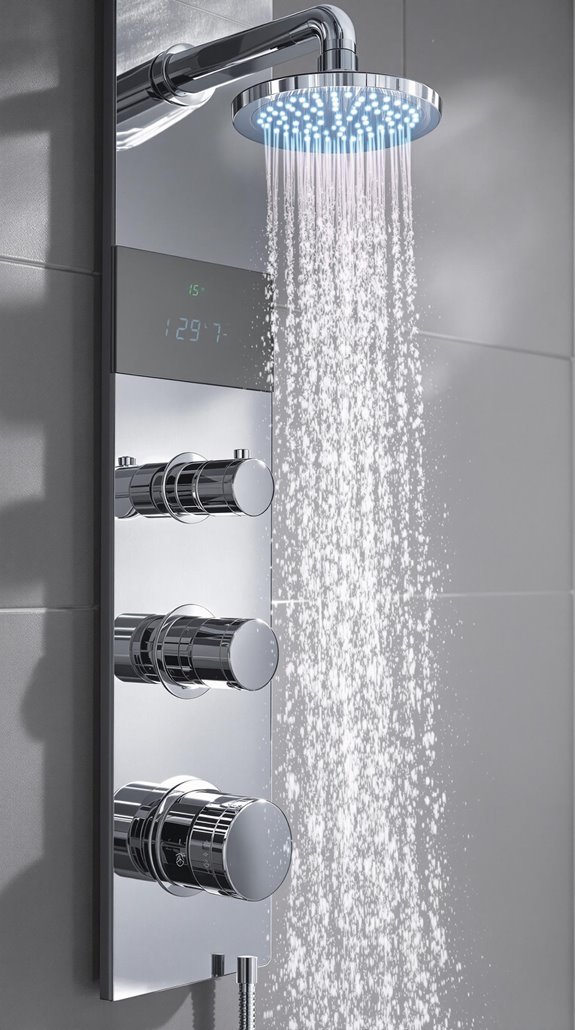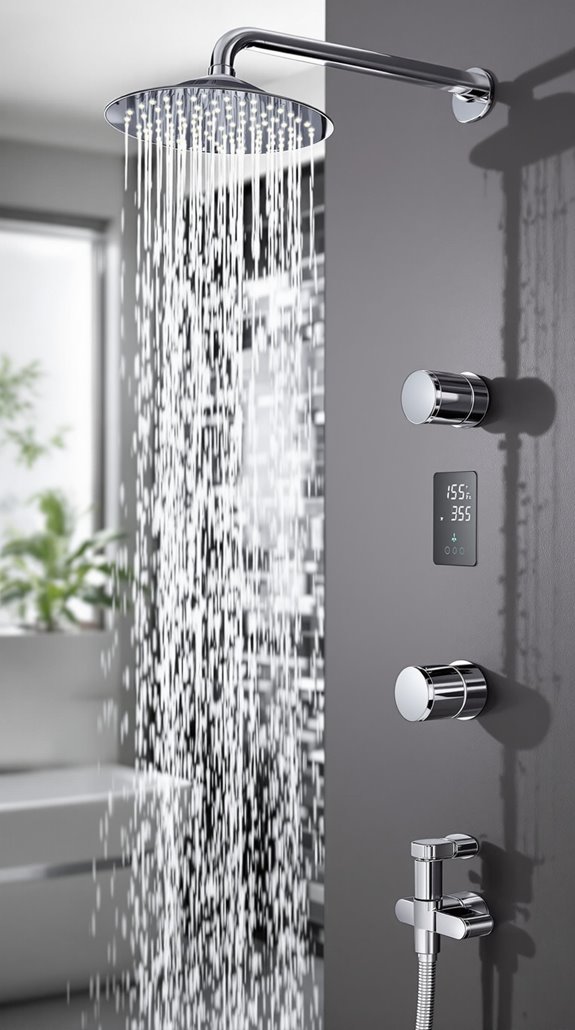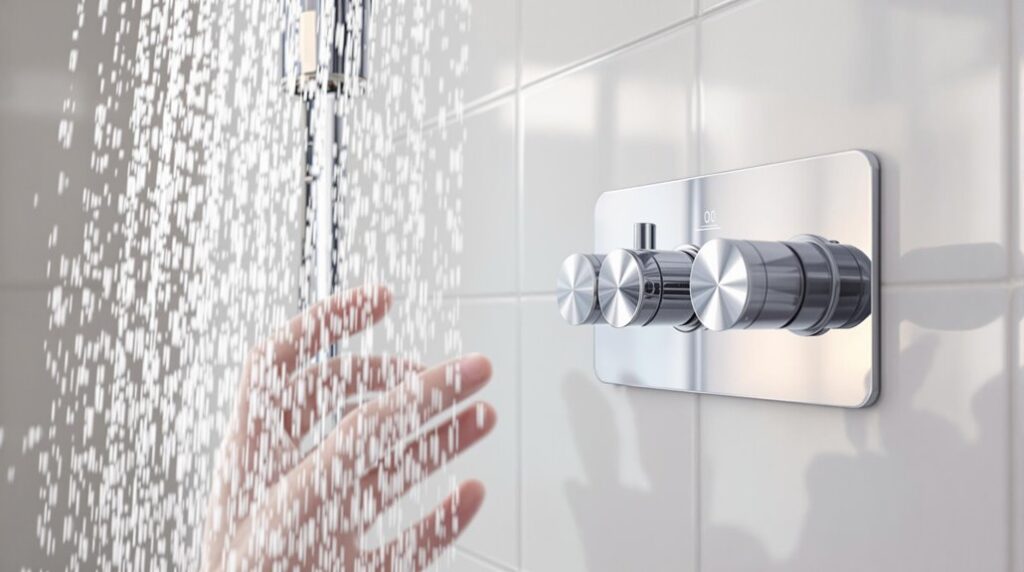I’ve been analyzing thermostatic showers for years, and I’ll tell you straight—they’re not the simple upgrade most homeowners think they are. While these temperature-regulating systems promise consistent water temperature and enhanced safety, there’s a complex web of installation requirements, compatibility issues, and cost considerations that can make or break your investment. Before you commit to this bathroom upgrade, you’ll need to understand exactly what you’re getting into.
Key Takeaways
- Thermostatic showers maintain consistent water temperature within ±1°C accuracy, eliminating sudden temperature shocks and enhancing user comfort.
- Higher upfront costs ($260-$4,000 plus installation) are offset by 25-30% water and energy savings over time.
- Built-in safety features including temperature limiters and automatic shut-off prevent scalding, especially beneficial for families with children.
- Installation requires specialized plumbing expertise and may have design limitations incompatible with traditional bathroom aesthetics.
- Advanced thermostat components need manufacturer-specific maintenance, making repairs more complex and potentially costlier than standard valves.
What Is a Thermostatic Shower and How Does It Work?

Temperature consistency transforms your shower experience from a daily guessing game into a predictable, comfortable routine. A thermostatic shower automatically maintains your preferred water temperature without manual adjustments, using a built-in thermostat that continuously regulates heat levels.
Here’s how it works: The thermostatic element—a wax and metal component—senses temperature changes in milliseconds. When water gets too hot or cold, this element expands or contracts, moving a piston that adjusts the hot-cold water mix ratios. A return spring stabilizes the system during sudden pressure changes, like when someone flushes a toilet.
You’ll set your desired temperature once using the temperature controller, while the separate flow control handle manages water pressure independently. This non-electric system maintains ±1°C accuracy, delivering consistent comfort every time. The system ensures consistent temperature regardless of other plumbing activities happening simultaneously in your house.
Key Benefits of Installing a Thermostatic Shower
Five major advantages make thermostatic showers worth considering for your bathroom upgrade. First, I’ll highlight the consistent temperature maintenance that eliminates sudden cold shocks when someone uses water elsewhere in your home. The internal thermostatic cartridge automatically balances hot and cold water ratios, so you won’t experience those jarring temperature shifts.
Second, enhanced safety features protect your family through built-in temperature limiters that prevent scalding. The system defaults to cold water during hot-water supply failures, making it ideal for households with children or elderly members.
Third, you’ll achieve significant water and energy savings—studies show 25-30% reduction in water waste since you won’t need to run water while adjusting temperature manually. The system also eliminates waiting time for temperature adjustments, providing enhanced comfort by removing the need for manual temperature corrections during your shower. Finally, the superior user experience and long-term reliability make this investment worthwhile for serious homeowners.
Potential Drawbacks and Limitations to Consider
While thermostatic showers offer compelling advantages, several significant drawbacks warrant careful consideration before making this investment.
Cost Impact
You’ll face substantially higher upfront costs—typically double that of pressure-balance valves—plus mandatory professional installation expenses that can strain your budget.
Installation Complexity
The two-handle design with wall-mounted plate requirements demands specialized plumbing expertise, making DIY installation nearly impossible and increasing overall project costs.
Maintenance Demands
Advanced components like digital displays and precision valves require manufacturer-specific maintenance protocols, leading to higher long-term service costs than traditional systems. Budget constraints may limit accessibility for consumers considering these ongoing expenses.
Design Constraints
Contemporary styling limits compatibility with traditional bathroom aesthetics, while the dual-handle configuration complicates both installation logistics and daily operation compared to single-handle alternatives.
Cost Analysis: Initial Investment Vs Long-Term Savings
Understanding the true financial impact of thermostatic showers requires examining both upfront expenses and potential long-term benefits. I’ll break down the real costs you’re facing.
Initial investment includes the unit itself, ranging from $260 to $4,000 depending on features and brand quality. Installation labor adds another $400 to $2,000 to your total expense. You’re looking at a substantial upfront commitment.
However, thermostatic showers deliver consistent temperature control, reducing water waste during temperature adjustment periods. This efficiency translates to lower monthly water bills over time. The safety benefits also matter financially – preventing scalding incidents protects your family from potential medical costs. Additionally, investing in a thermostatic shower can contribute to early detection of subsidence, as it encourages better maintenance of plumbing systems that could otherwise lead to structural issues.
While I can’t provide specific savings percentages, the combination of reduced water consumption and enhanced safety features typically justifies the initial investment for most homeowners. Most installations are completed within 0.5 – 1.0 day, minimizing disruption to your daily routine during the upgrade process.
Making the Right Choice for Your Bathroom Upgrade

Three key factors determine whether thermostatic showers align with your specific bathroom upgrade goals: your household’s safety requirements, existing plumbing infrastructure, and budget constraints.
If you’re prioritizing safety—especially with children or elderly family members—I’d recommend thermostatic showers as essential upgrades. The built-in temperature limits and automatic shut-off features provide peace of mind that standard mixers can’t match. Additionally, installing a thermostatic shower can contribute to improved thermal efficiency, which is crucial for reducing energy consumption in your home.
Your existing plumbing setup matters greatly. Most thermostatic units integrate seamlessly with standard configurations, but you’ll need adequate water pressure for peak performance. The dual control design allows you to adjust both water flow and temperature independently for optimal comfort.
Budget-wise, consider the long-term savings. While initial costs run higher, you’ll recoup expenses through reduced water waste and energy consumption. The 40-50% water savings alone justify the investment for most households seeking efficient, safety-focused bathroom solutions.
Conclusion
After evaluating the technical specs and cost-benefit analysis, I’d recommend thermostatic showers if you’re prioritizing safety and long-term efficiency. The upfront investment typically pays off through reduced utility bills and enhanced scalding protection. However, if you’re working with limited budgets or older plumbing systems, standard mixers might suffice. Consider your household’s specific needs, existing infrastructure, and safety priorities when making this decision. The upgrade’s worthwhile for most modern bathroom renovations.
References
- https://bespoketaps.com/blogs/news/thermostatic-shower-not-hot-enough-water
- https://starbathus.com/blogs/news/is-thermostatic-shower-system-worth-it
- https://houseofenki.com/blogs/guides/thermostatic-shower-vs-electric-shower
- https://www.jaquar.com/en/blog/benefits-of-thermostatic-shower-valves
- https://www.rbrohant.com/blogs/news/advantages-of-thermostatic-shower-system
- https://www.victorianplumbing.co.uk/bathroom-ideas-and-inspiration/how-do-thermostatic-showers-work
- https://posh.co.uk/living/what-is-a-thermostatic-shower-how-does-it-work/
- https://starbathus.com/blogs/news/what-is-the-difference-between-a-thermostatic-and-non-thermostatic-shower
- https://www.premiercareinbathing.co.uk/blog/accessories/thermostatic-showers-explained/
- https://www.bathroomsuppliesonline.com/blog/how-do-thermostatic-shower-valves-work/

